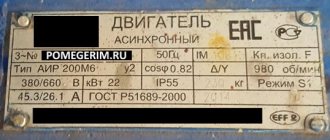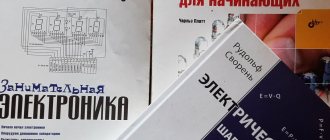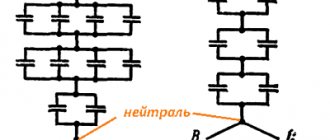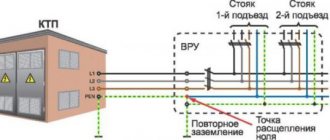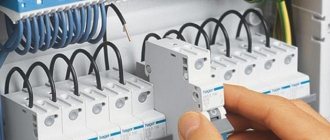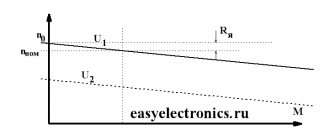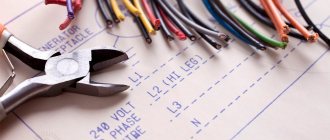Technologies do not stand still. Surely everyone is familiar with the expression “knocked out the traffic jams.” This is what they usually said when suddenly the electricity in the apartment went out for some reason.
Today there are no traffic jams anymore. Moreover, modern automation in the apartment has become much more compact and, at the same time, more functional. In modern electrical installations, devices called “differential circuit breakers” are increasingly used. In this article, we would like to look a little at what kind of beast this is and answer the question of which difavtomat to choose for your home.
What is Difavtomat?
Difavtomat
in electrics (or RCBO, or residual current circuit breaker) is a device that is designed both to protect wiring from overload and to protect a person from electric shock. To make it more clear, let's look at the purposes of devices, a hybrid of which is a difavtomat: a circuit breaker and an RCD.
Circuit breaker
is a device whose main task is to protect wiring from overload. What does this mean? In addition to the secondary characteristics, the machine has a main one - the rated current value. For example, it is customary to buy machines with a rating of 16 amperes per line of outlets. What does 16 ampere rating mean? This means that this device will constantly monitor the current strength and as soon as it notices that the current strength has exceeded 16 Amps, it will open the circuit. Why is it important? But because the wiring and modern sockets are designed specifically for a maximum current of 16 amperes. Consequently, if there is a current in the network for a long time that significantly exceeds this value, the sockets and wiring will begin to melt, which can lead to a fire.
RCD
(residual current device) has a slightly different purpose.
Unlike a circuit breaker, an RCD does not protect wiring from overheating. When you see a 16 amp designation on a circuit breaker, it means that the circuit breaker will simply turn off and open the circuit when the current exceeds the rated current.
When you see a similar designation on an RCD, this indicator means the maximum current value at which the RCD will operate. If the current is greater, the RCD will simply burn out (while the circuit breaker will turn off and remain operational). The main task of an RCD is to control current leakage. By and large, first of all, this means protecting a person from electric shock.
That is, what can we say: The direct task of the machine is to protect the wiring. The direct task of the RCD is to protect people from electric shock.
A difavtomat is nothing more than an RCD and an automatic device in one housing. that is, the difavtomat performs two tasks at once - it protects a person from electric shock and protects the wiring from overload.
What are the analogues?
The functions of protection against short circuits and current overloads are performed by electrical circuit breakers (AVs), which have long replaced plug fuses from use. Triggering of current leaks is provided by products that have relatively recently become a mandatory element of electrical networks, called residual current devices (RCDs). Recently, differential circuit breakers with protective functions against both short circuits and leakage currents have become especially popular. A person, especially one who is not experienced in electrical engineering, sometimes cannot decide what to choose as protection for the electrical equipment of the electrical network, a differential circuit breaker or a combination of a circuit breaker and an RCD.
There is no clear answer to the question of which equipment to choose, because both the automatic circuit breaker and the residual current device have both advantages and disadvantages. Ultimately, it all depends on the specific circumstances. In one of our articles, we considered the question of what to choose: a differential circuit breaker or an RCD.
Characteristics of difavtomats
So, let's assume that you decide to buy a automatic machine. How to understand which option is right for you? Let's look at the main designations of difavtomats.
Modules, poles, phases.
These concepts are often confused. Let's do it this way.
- Phase is what system the difavtomat is designed for. There are only two options - 1 phase (domestic) and 3 phases.
- Polarity is the number of clamps on a difavtomat. That is, this is how many lines you need to connect. There are two-pole difavtomats (for single-phase networks) and four-wheel difavtomats (for three-phase networks).
- The number of modules is the size. For example, two-pole automatic circuit breakers (for single-phase networks) are usually made two-module (that is, they occupy 2 modules in the panel). But they also come in single-module (super compact) and three-module (usually very budget options).
If you choose a difavtomat for an apartment, 90% of the time you need a two-module, two-pole and single-phase difavtomat.
How to choose a machine for electrical wiring
A machine for a private house or apartment is chosen depending on its characteristics. They are indicated on the device body. The main designations include:
- name abbreviation – AVDT;
- rated current parameters – C (dependence of time and current), number (limit current, the value of which cannot be exceeded);
- rated voltage for household network – from 220 to 230 V;
- leakage current parameter – 30 mA;
- a symbol confirming the presence of AB and RCD functions.
The current requirements of 30 mA, at which the device turns off, are specified in the PUE.
The optimal electrical circuit breaker with AB and RCD functions for installation in an apartment panel is single-phase, with a value of 220/50. For a private home, it is worth buying a three-phase device with values of 380/3. When purchasing, you should also pay attention to other selection criteria.
Short circuit current
For lighting networks, it is worth choosing models with nominal values of 10-30 mA. For single circuits, a 10 mA machine is suitable, for group circuits - 30 mA. Devices with nominal parameters from 100 to 300 mA are placed at the input.
Nominal value and class of the difavtomat
These indicators answer the questions:
- How quickly will the automat operate when overloaded?
- At what current value will the automatic circuit breaker operate?
On the market you can find classes A, B, C, D. A is the fastest, D is the longest. For domestic use, mainly class B and class C are used. Why is this so? If you install a class A machine in your apartment (although it costs several times more than B and C), then every time you turn on the vacuum cleaner, the automatic machine will work. This is due to the fact that when the vacuum cleaner is started, the current in the network increases sharply for a short period of time. But class A is very sensitive and therefore will work immediately.
If you set class D, the device will not respond quickly enough.
As for the nominal value, it all depends on your tasks.
Diphavtomats with a rating of 16 amperes are installed on the line of sockets. For the lighting line - rated at 10 amperes.
Test button
Must be present on all automatic machines. Simulates current leakage. Manufacturers recommend pressing it at least once every three months.
Trigger type
This characteristic means what currents the difavtomat reacts to.
Type A - such a device responds to alternating and pulsed current. It costs several times more than the AC type. Sometimes washing machine manufacturers recommend installing such devices on the washing line. The reason for this is that the washing machine creates a pulse current (that is, current, then not).
AC type is the most popular option. Responsive to alternating current.
Everything is simple here - if there are no special instructions or devices - install AC type automatic machines.
Leakage current
This indicator indicates how sensitive the automatic machine is. As a rule, difavtomats with a leakage of 30 mA (milliamps) are used. This is taken into account optimally for human protection - not too sensitive for false alarms, but sensitive enough to protect a person from electric shock. MUCH less often you can find 10, 100 and 300 mA difautomats. We believe that this is due to the demand for devices.
Device type of difavtomat
This characteristic means how the difavtomat reacts to current leakage. There are two main categories here
Electromechanical automatic machines.
The most popular option. As a rule, they cost more than electronic ones. Such automatic devices trigger a leak regardless of the presence of voltage in the network. They are considered more reliable solutions.
Electronic automatic machines.
This type of device reacts only when there is voltage in the network. This means that if the zero is broken, the difavtomat will not protect against current leakage. Such automatic machines are presented in the Legrand RX and Schneider Easy9 series.
In order to understand what type of automatic machine is in front of you, you need to study the diagram.
For electronic automatic devices, the operating diagram always shows a circuit board with an amplifier in the form of a triangle (this is a symbol for amplifiers according to GOST).
We recommend using electromechanical automatic machines. They are more reliable and are not much more expensive than electronic ones.
Criterias of choice
Having given preference to a difavtomat, you need to carefully consider the process of selecting it. Initially, you need to familiarize yourself with the performance characteristics of the product.
Rated voltage and phase pattern. Choosing the right differential machine in accordance with the required parameters is not difficult. Devices designed to operate in a single-phase network (220 V) are equipped with three connection terminals, while devices for three-phase networks (380 V) are equipped with four poles. The rated operating voltage is indicated in the passport and marked on the product body.
Current rating and characteristics. In order to ensure high-quality operation of the differential machine, it is important to choose the correct current rating and characteristics. Information about these parameters is indicated by a letter of the Latin alphabet and a number, for example, C25, which means a device with characteristics C, with a rated operating current of 25 A. The most popular differential automatic machines for apartments and private houses are products with characteristics C. When choosing a differential automatic machine based on power, it is recommended to adhere to values indicated in the table:
Leakage current. Indicated by the “delta” symbol with a number corresponding to the rated leakage current in milliamps. The data in the second table will help you choose the right circuit breaker based on leakage current:
Important! For a water heater, washing machine, bathroom or bathhouse, you need to choose a device that operates at 10 mA. For a group line, it is enough to select a 30 mA characteristic if you decide to divide the wiring into groups. For input into a private house, to protect against fire, it is recommended to install a 300 mA difavtomat, and in apartments it is enough to use a device rated at 100 mA.
RCD class . The RCDs built into the differential circuit breaker are divided into two classes:
- A - triggered as a result of DC leakage. To connect consumer electronics consumers to the network, you should select an RCD of this class
- AC - turn off the automatic circuit breaker when AC leaks appear in the network and on electrical equipment.
Protection against neutral conductor breakage. Some difavtomats are equipped with units that disconnect consumers in the event of a break in the neutral wire. When arranging equipment protection against current leakage, it is advisable to choose just such a product. Another important characteristic is the shutdown time (denoted as Tn). It should not be more than 0.3 s.
For a person who is unsure that he will be able to choose a difavtomat himself, it is recommended to make a purchase from trading companies with a high reputation, where he should seek help from a qualified consultant. You can discuss with him the issues of an acceptable price and which manufacturer of differential automatic machines should you choose.
Finally, we recommend watching a useful video on the topic:
So we looked at how to choose a difavtomat based on power and leakage current. We hope the information provided helped you understand the choice of a suitable differential machine for your home, cottage or apartment!
We also recommend reading:
Calculation of circuit breakers
Before purchasing a difavtomat, it is important to calculate it in such a way as to ensure timely operation and protection without failure of electrical appliances.
Determining the power of the machine
The calculation of the machine according to the power of the electrical receiver is carried out when the wiring along the entire length is designed for a certain type of load. The permissible current in this case will be greater than the rated parameters of the machine.
Calculation of the rated power of the machine
To avoid doing calculations, you can:
- View documentation of household appliances.
- Review the information on the back panel.
- Use the table with average power values of devices.
| Type of electrical appliance | Power consumption, W |
| Washing machine | 2000-2500 |
| Electrically heated floor | 2000-2500 |
| Electric stove | 4500-8500 |
| Dishwasher | 2000-2500 |
| Fridge | 140-300 |
| Mixer | 250-400 |
| Hairdryer | 400-1600 |
| Iron | 900-1700 |
| Vacuum cleaner | 680-1400 |
| Fan | 2500-4000 |
| TV | 125-180 |
| Lighting | 20-100 |
Starting power may differ from rated power.
Rated current calculation
When calculating the rated current, they are guided by the cross-section of the wire. The rated current of the machine must be less than the maximum value designed for this cable.
The machine is selected according to the minimum cross-section of wires. For example, for a copper cable with a cross-section of 1.5 mm2, the permissible current is 25 A. A machine with a value of 25 A will lead to overheating of the wiring. That's why:
- The power of the loads on the differential circuit breaker is calculated.
- The power of all consumers is calculated.
- A calculation is made using the formula for the design current of the machine I = P/U, where P is the total power of all electricity consumers U is the network voltage.
- The result is rounded.
If wiring has not been done, you can calculate the sum of all devices in the network and select a machine with a rating that matches the calculated result. The wire cross-section must be selected according to the rating of the device.
Determination of time-current characteristic
Special graphs are used to express the time-current characteristics. The curve indicates the response of the machine when the current is turned off. The dependence of the response time of the device on the strength of the current passing through it will be this indicator.
The most common characteristics are:
- B – from 3 to 5×In;
- C – from 5 to 10×In;
- D – from 10 to 20×In.
The letter indicates the operating current.
